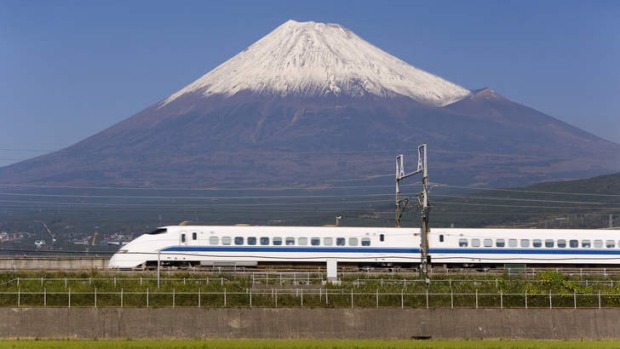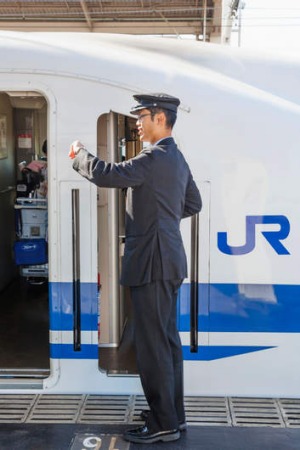
Stephen Lacey sets out to fulfil a lifelong dream on the bullet train to Mount Fuji.
My 1960s Point Clare childhood was filled with dreams of trains. They rumbled through our sleep heading to a city, their sides damp with dew and night. Sometimes the "goodsies" rattled the willow pattern off the plates.
My nanna's soft voice measured the time by the trains. "That will be the Newcastle Flyer," she'd say. And she'd anxiously await the "paper train" with its bundles of news and gossip.

I grew to love the grunting diesels hauling loads of coal from Newcastle, NSW, and the red rattlers with their cargo of sleepy commuters.
Then one day at school one of my classmates returned from a trip to Japan. This classmate's parents had won some money in the Opera House lottery and taken their son to Tokyo. One of the souvenirs he brought to school was a plastic ruler on which were images of a train zooming past a cone-shaped mountain. "It's called the bullet train, and that's Mount Fuji," he told the class.
I promised myself that one day I would see the bullet train and ride it right past that perfect volcano.
A lot of locomotives were to pass under the railway bridge of life before that day arrived. But here I am some 40 years later, pushing through the crowds on Tokyo station dizzy with anticipation, about to board the bullet train from platform 15.
In Japan the train is known as the Shinkansen (which literally translates as new trunk line, referring to the tracks themselves). Incredibly, construction on the first segment of the Tokaido line from Tokyo to Osaka began way back in 1959. The O-series Shinkansen made its public debut in 1964, speeding along at up to 210km/h.
This was at a time when the most exciting rail development in Australia was the introduction of double-decker carriages on the Sydney rail network.
The Shinkansen was — and is — so advanced that even today, the record speed of an Australian train (Queensland Rail's Tilt Train hit 210km/h during a trial run in 1998) is merely a warm-up for the current N700 series Shinkansen, which operates daily at 300km/h. The E6 series (due to run next year) will be operating at up to 320km/h.
On booking my ticket for the Shinkansen I was surprised to discover that there isn't just one bullet train. There are loads of them. In fact the Tokaido Shinkansen is the busiest high-speed rail line in the world, with up to 13 trains running an hour in each direction and carrying about 150 million passengers a year. And that's just one of several Shinkansen networks that link most of the major cities on Honshu and Kyushu, along more than 2300 kilometres of lines.
My excitement levels rise when I wander up to the platform and see it waiting there, hissing.
The Shinkansen has just arrived from Osaka and an army of women in baby-pink uniforms is spread out along the platform waiting to go aboard and clean it. Smartly dressed conductors in hats and pressed beige suits stand at attention. I step aboard and find my reserved seat. At 10.33am precisely we start to move away from the station. The punctuality is impressive, with reports revealing that average arrival times are within six seconds of the timetable.
Because I have booked with a JR Pass, I'm not entitled to ride on the super-fast Nozomi train that only stops at Shinagawa, Yokohama, Nagoya and Kyoto before reaching Osaka (the equivalent distance of Sydney to Coffs Harbour) in less than 2½ hours. I'm happy enough on the Hikari, which stops at a lot more stations.
For the first 20 minutes we move through the sprawling metropolis of Tokyo, after which a creamy surge of speed reduces the foreground to a concrete-grey blur. Considering the velocity we're pelting along at, it's remarkably smooth and quiet, with the train leaning into the banked corners, and just the whine of the electric motors audible.
The scene flickers past the window: hillside graveyards in weathered granite, verdant foothills of lime-green forest, a baseball game played beside a belching factory, washing-line apartments dripping with airconditioners.
A woman comes through the carriage, pushing a trolley selling snacks and sandwiches, green tea ice-cream, coffee, beer and whisky. "When do we see Mount Fuji?" I ask her. She smiles and looks at a timetable. "At 11.21," she replies.
I can't help but be impressed by her precise answer.
After a wander through the train's 16 carriages, I glance at my watch. It's 11.21. But there is no sign of Mount Fuji. Could the Shinkansen's much-lauded punctuality have failed? I ask one of the other passengers what's going on.
"Fuji is right there," he tells me. "But she's covered in cloud. Sometimes she doesn't want to be seen." Oh well, Fuji can wait. Today I'm riding the bullet.
The writer travelled with the assistance of the Japan National Tourist Organisation.
Since the Japanese launched the Shinkansen in 1964, many countries around the globe have adopted high-speed rail. Here are just a few of them:
France The TGV (Train a Grande Vitesse) was developed during the 1970s and now operates throughout France with links to neighbouring countries. The TGV regularly operates at 320km/h, but a test train hit 574.8km/h in 2007. tgv-europe.com/en/.
South Korea The KTX (Korea Train Express) started in 2004 on the Seoul to Busan run. Currently the KTX has a top speed of 305km/h, but this is expected to rise to 350km/h by 2014. info.korail.com/2007/eng/eng_index.jsp.
China The largest high-speed rail network in the world, with more than 9000 kilometres of routes, includes the 2298-kilometre stretch from Beijing to Guangzhou. The Maglev (magnetic levitation) line from Shanghai Airport to the city is the fastest in the world at 431km/h. Official websites are all in Chinese.
Germany In 1933 the diesel-powered Fliegender-Hamburger reached 160km/h. Nowadays the ICE (Inter-City-Express) travels at a service speed of 330km/h. The ICE links Germany with Austria, Belgium, Denmark, France, The Netherlands and Switzerland. eurail.com/trains-europe/high-speed-trains/ice.
Spain At almost 3000 kilometres and growing, Spain's LAV (Lineas de Alta Velocidad) network is second only to China. The high speed Barcelona-Figueres (France) line opened in January, with a direct Paris-Barcelona-Madrid line commencing in April. The trains operate at up to 310km/h. eurail.com/trains-europe/high-speed-trains/ave.
Getting there
JAL flies direct to Tokyo's Narita Airport, from Sydney International, seven days a week. 1800 802 228, jal.com.au.
Staying there
The writer checked in at the magnificent new Palace Hotel in the Maranouchi district of Tokyo (right beside the Imperial Gardens). Rooms start from about $600 a night. palacehoteltokyo.com/.
The Bullet Train
Before you leave, buy a JR Pass from a Japanese travel agent in Australia — a list of agencies can be found at jnto.org.au/search-tour-operators/.
The pass entitles you to consecutive days' unlimited travel on the Shinkansen and all JR trains throughout Japan.
jnto.org.au/